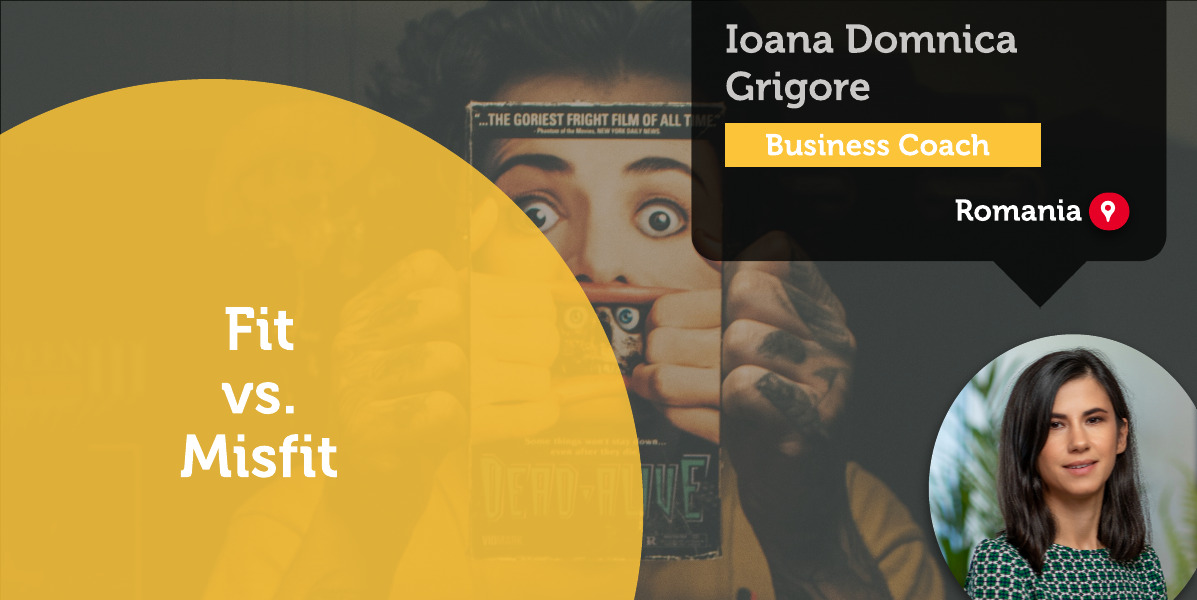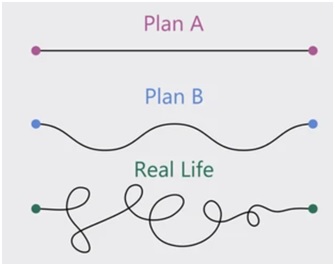A Coaching Power Tool By Ioana Domnica Grigore, Business Coach, ROMANIA

Fit vs. Misfit Building Balance Between Business and Private Life
Many solopreneurs start their businesses out of the desire to make money from a passion or talent they have. As an example, I worked with a female solopreneur that loved to dance. She was talented and she dedicated many practice hours since she was a little girl. After conquering all the national dance contests, she wanted to help others through dance, while making it her main income source. So she developed a very successful dance therapy program.
Sounds like an easy success story, isn’t it? Well….it wasn’t!
She was the only team member of her business, doing it all: accounting, finance, project management, sales, marketing, and, above all, executing the dance moves together with her clients.
The challenge there was that she was surrounded by a lot of fears and limiting beliefs: fear of failure, impostor syndrome, fear generated by the lack of know-how, not being able to assess own abilities and skills, underlying beliefs such as “I am a creative person and I don’t know how to make business” and, above all, the need of constantly being in control (when you are the one-man-show it’s hard to assume that there might be somebody able to help you).
She reached success after more than 6 years of trials and errors, while being a constant learner – developing and reinventing herself daily.
What she needed to accept was that life is not as you plan it and that you need to adapt each time it doesn’t fit you anymore – personally or professionally.
 In today’s complex and challenging environment, it is easier than ever to feel disoriented, anxious, and lose sight of what fits you and what it is not. This phase is called a mismatch crisis. This is expressed by the anxiety you experience when your reality or something in your reality doesn’t fit you anymore. This might happen not only in a professional or entrepreneurial setup but also in a personal one.
In today’s complex and challenging environment, it is easier than ever to feel disoriented, anxious, and lose sight of what fits you and what it is not. This phase is called a mismatch crisis. This is expressed by the anxiety you experience when your reality or something in your reality doesn’t fit you anymore. This might happen not only in a professional or entrepreneurial setup but also in a personal one.
When you become aware that the life you are living does not fit your dreams and needs anymore, you have to be willing to change, to adjust the sails.
The fear of change is therefore the biggest fear that needs to be addressed through coaching.
What Is the Difference Between Fit vs. Misfit? What Does Being “Fit Within Your Life” Mean?
According to Merriam-Webster Dictionary, fit means to be adapted to the environment to be capable of surviving, or adapted to an end or design, or suitable by nature or by art, and to be in agreement or accord with, to be in harmony or accord; whereas misfit represents a person who is poorly adapted to a situation or environment, something that fits badly.
In biological terms, “being fit” means “being able to provide for one’s own life and wellbeing; the fittest are those who can do so the best.” As in biology, being fit in life means being able to provide the life you dream of, the life you deserve.
So, the action of the fitting is about your reality matching your expectations, needs, and dreams. Once you become aware that there is a misfit, you should work towards finding a fit scenario and implement it.
This power tool approaches the fit-misfit context from two (client’s) perspectives:
From a Professional Perspective:
- Is the business going in the right direction?
- Am I approaching it strategically enough?
- What am I missing?
- Do I have what it takes to make it successful?
- What is that I don’t know?
From a Personal Perspective:
- Is this what I want to do with my life?
- Do I have what it takes to be an entrepreneur?
- What do I need to be a successful entrepreneur?
Tools for Fit vs. Misfit Scenario
Just like when your jeans do not fit you anymore and you decide to lose weight or buy a new pair, the solopreneur assesses his current situation, decides whether it fits his expectations or not, and then looks for ways to change or improve it.
This tool helps identify, reframe and turn a perspective around. It can be applied during a coaching session and the best way to do it is to start by having meaningful conversations to discover the current situation and if it’s fit or not (AS IS), envision a new perspective (AS YOU WANT IT TO BE) and then work on implementing it (ACTION PLAN).
Questions That Can Be Used to Help the Person Highlight Their Current Situation:
- At this point, what’s happening to you? What impact or influence is this having?
- What is driving or pushing the need to change? What is missing?
- How important is getting a fit entrepreneur life for yourself?
- What do you benefit from living a fit entrepreneur life?
- What are you ready to change?
- What is holding you back?
- What do you need to look at?
Questions Exploring the Mismatch:
- What is telling you that you are in a misfit situation?
- How does it feel?
- What does it serve? What does it not serve?
- What is the desired outcome?
- What do you see as being the real challenge right now?
- What is it specifically that you want to achieve?
- Tell me why you see this as an ideal professional outcome?
Questions Exploring the Change and Transition From a Misfit Situation to a Fit One:
- What are your concerns about this change?
- What will help you prepare for this change?
- How are you feeling about this change?
- What are the benefits of this change?
- How can I support you as you process this change?
Questions for Building the Action Plan Towards a Fit Scenario:
- What life do you imagine for yourself as an entrepreneur?
- What is the goal, intent, or motive you want to set for yourself?
- What commitment do you want to set for yourself?
- What is your next step?
- What information, resources, or training do you need?
- What attitude can best serve you as you think about the tasks you need to complete?
- What else may be possible?
- What could you do differently this time around?
- What positive things do you feel will happen if you accomplish what you’re trying to achieve?
- What are you most proud of as you were working through this transition?
Fit vs. Misfit Scenario
A woman on maternity leave decides to change her life by starting her own business by selling her own painted products. The main reasons that triggered this change were that she wanted to spend more time with her family and have a flexible schedule.
Six months later she talks to her coach saying that the entrepreneurial life is not as she thought it would be: she works more than ever and she is always exhausted and with little time and energy for her family.
The main struggle here is that she is not happy with her current situation, but she is not yet ready to give up. In this case, change doesn’t come as an easy answer to her problems.
In the book “Think again”, Adam Grant talks about the concept of escalation of commitment. “When we dedicate ourselves to a plan and it isn’t going as we hoped, our first instinct isn’t usually to rethink it. Instead, we tend to double down and sink more resources in the plan. Escalation of commitment happens because we’re rationalizing creatures, constantly searching for self-justifications for our prior beliefs as a way to soothe our egos, shield our images, and validate our past decisions. Escalation of commitment is a major factor in preventable failures.”
In this case, this power tool helps the client rethink her plan instead of persisting with failing strategies that lead even more towards a misfit situation.
Before getting there though, she has to go through a deep exploration process meant to clarify the gap between the actual situation and the dreamt one. I would suggest that this is a vital step in the coaching process as the client needs to have clarity over two things: that the situation she dreams of is not a utopia and that she is still able to make it work.
The coach should help her to:
- explore the current situation
- reflect on the desired situation
- envision the path she needs to follow to get from misfit to fit entrepreneurial life
- build a robust action plan to navigate towards the desired situation
Additional Tools for Fit vs. Misfit Scenario
The Pre-mortem Analysis
This is a tool created by myself and inspired by the business environment. It represents a strategy that uses the post-mortem framework, but occurs early in the planning process, before starting a project.
The coach invites the client to imagine that the business is complete, but has gone badly (such as bankruptcy, insolvency, etc). The client will propose the likely failures and possible causes. The client uses the results of the exercise to work backward and make changes to processes to prevent imagined failures from occurring.
Here are some example post-mortem questions:
- What’s missing from the business plan?
- What could slow down the business?
- Who or what owns the biggest areas of risks?
- Which change brings the biggest impact?
Plant Your Dreams
This is a tool created by myself and inspired by a list of daily rituals.
Seeds are magical. They’re like tiny factories, designed to contain absolutely everything they need to become a fruit, vegetable, flower, bush—even the tallest, most majestic tree. This is a ritual perfect for setting goals, reminding yourself of your progress, and staying connected to your growth.
Planting a seed is the perfect metaphor for manifesting the goals and dreams you’re working toward.
When the client starts working toward the fit scenario he envisioned, the coach invites him to plant a seed at the same time. This is powerful work—putting all of your intentions into a seed, planting it, and taking care of it while it sends down roots, breaks through the soil, and grows toward the light.
The client will remember that he is nourishing not just another living thing, but also himself at the same time. As a coach, remember that just like the seed, the client has everything within him to make his dream happen.
What happens when the goal is reached or the plant is fully grown? The client keeps nurturing his plant. It will be a precious reminder of the journey he has traveled.
- Write down a situation where your reality didn’t match expectations and think of your reaction to it.
- How will you practice moving from a state of misfit to a state of fit?
- What tools you may consider using to feel more open to change?
References
https://www.merriam-webster.com/
https://medium.com/
https://www.smartsheet.com/
“Think again” by Adam Grant
“The rituals” by Natalie Macneil